Share common Redis interview questions

Introduction: Redis is an open source log-type, Key-Value database written in ANSI C language, complying with the BSD protocol, supporting the network, and can be based on memory or persistence, and provides Non-relational database with APIs in multiple languages.
Special recommendation: 2020 redis interview questions collection (latest)
Traditional databases follow ACID rules. Nosql (abbreviation for Not Only SQL, a collective name for database management systems that are different from traditional relational databases) is generally distributed and distributed generally follows the CAP theorem.
Github source code: https://github.com/antirez/redis
Redis official website: https://redis.io/
Recommended: "redis Tutorial》
#What data types does Redis support?
String string:
Format: set key value
The string type is binary safe. This means that the redis string can contain any data. For example, jpg images or serialized objects.
The string type is the most basic data type of Redis, and a key can store up to 512MB.
Hash(Hash)
Format: hmset name key1 value1 key2 value2
Redis hash is a set of key-value (key=>value) pairs.
Redis hash is a mapping table of string type fields and values. Hash is particularly suitable for storing objects.
List (List)
Redis list is a simple list of strings, sorted in insertion order. You can add an element to the head (left) or tail (right) of the list
Format: lpush name value
Add a string element to the head of the list corresponding to the key
Format: rpush name value
Add string elements at the end of the key corresponding list
Format: lrem name index
Delete count items from the key corresponding list that are the same as value Element
Format: llen name
Returns the length of the key corresponding to the list
Set (set)
Format: sadd name value
Redis's Set is an unordered collection of string type.
Sets are implemented through hash tables, so the complexity of adding, deleting, and searching is O(1).
zset(sorted set: ordered set)
Format: zadd name score value
Redis zset, like set, is also a collection of string type elements, and duplicates are not allowed member.
The difference is that each element is associated with a double type score. Redis uses scores to sort the members of the collection from small to large.
The members of zset are unique, but the scores can be repeated.
What is Redis persistence? What persistence methods does Redis have? What are the pros and cons?
Persistence is to write the memory data to the disk to prevent the memory data from being lost if the service goes down.
Redis provides two persistence methods: RDB (default) and AOF
RDB:
rdb is the abbreviation of Redis DataBase
Function core functions rdbSave (generate RDB file) and rdbLoad (load memory from file) two functions

AOF:
Aof is the abbreviation of Append-only file
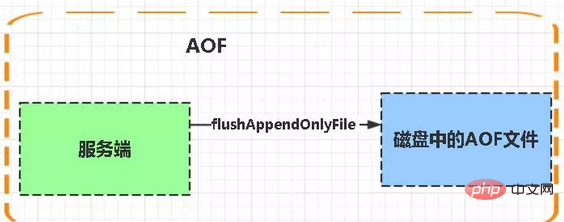
aof write and save: WRITE: According to the conditions, write the cache in aof_buf to the AOF file SAVE: According to the conditions, call the fsync or fdatasync function to save the AOF file to disk.
Storage structure:
The content is command text storage in redis communication protocol (RESP) format.Comparison:
1. Aof files are updated more frequently than rdb, so use aof to restore data first. 2. AOF is safer and larger than rdb3. RDB performance is better than aof4. If both are configured, AOF is loaded firstYou just mentioned the redis communication protocol (RESP) above. Can you explain what RESP is? What are the characteristics? (You can see that many interviews are actually a series of questions. The interviewer is actually waiting for you to answer this point. If you answer the question, it will add another point to your evaluation)
RESP It is a communication protocol previously used by the redis client and server; Characteristics of RESP: simple implementation, fast parsing, and good readabilityFor Simple Strings the first byte of the reply is " " ReplyFor Errors the first byte of the reply is "-" ErrorFor Integers the first byte of the reply is ":" IntegerFor Bulk Strings the first byte of the reply is "$" StringFor Arrays the first byte of the reply is "*" ArrayWhat are the architectural patterns of Redis? Talk about their respective characteristics
stand-alone version
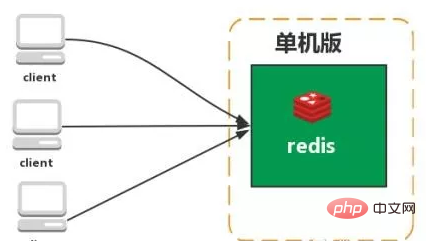
Features: Simple
Problems:
1. Limited memory capacity 2. Limited processing power 3. Unable to be highly available.
Master-slave replication
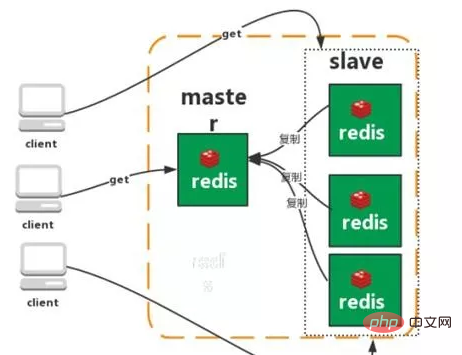
Sentinel
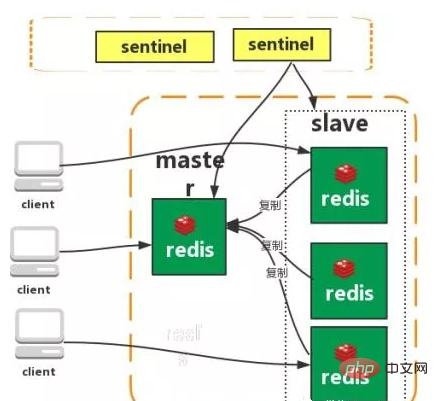
Cluster (proxy type):
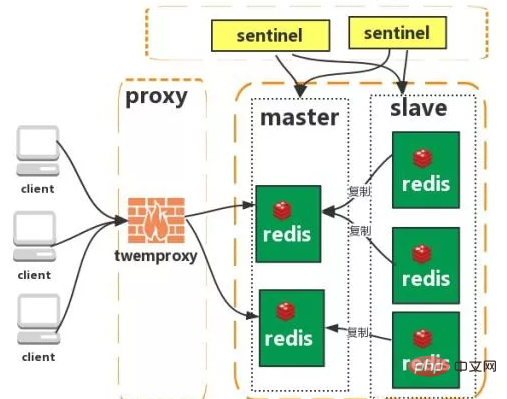
Cluster (direct Connection type):
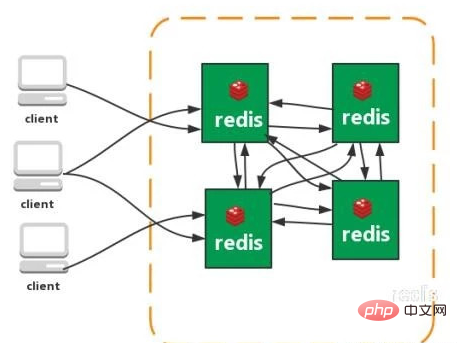
What is a consistent hash algorithm? What is a hash slot?
Commonly used commands in Redis?
Keys pattern* means allocating all starting with bitCheck whether the Exists key existsSet Set the value corresponding to the key to a string type value. setnxSet the value corresponding to key to the value of string type. If key already exists, return 0, nx means not exist. Delete a keyReturns 1 for the first time and returns 0 for the second time after deleting itExpire Set expiration time (in seconds)TTL view How much time is leftIf a negative number is returned, the key will be invalid and the key does not existSetexSet the value corresponding to the key to a string type value, and specify the corresponding value of this key validity period. MsetSet the values of multiple keys at one time. Returning ok on success means that all values are set, and returning 0 on failure means that no value is set. GetsetSet the value of key and return the old value of key.Mget
Get the values of multiple keys at one time. If the corresponding key does not exist, nil will be returned accordingly.
Incr
Add the value of key and return the new value. Note that if incr is a value that is not int, an error will be returned. If incr is a key that does not exist, set the key to 1
incrby
is similar to incr, add the specified value, and it will be set when the key does not exist key, and thinks that the original value is 0
Decr
The value of the key is subtracted. If the decr key does not exist, set the key to -1
Decrby
Same as decr, minus the specified value.
Append
Append value to the string value of the specified key and return the length of the new string value.
Strlen
Get the length of the value of the specified key.
persist xxx (cancel expiration time)
Select database (0-15 database)
Select 0 //Select database
move age 1// Move age to 1 library
Randomkey randomly returns a key
Rename rename
Type returns the data type
08
Have you ever used Redis distributed lock? How is it implemented?
First use setnx to grab the lock. After grabbing it, use expire to add an expiration time to the lock to prevent the lock from forgetting to release.
What happens if the process crashes unexpectedly or needs to be restarted for maintenance before expire is executed after setnx?
The set instruction has very complex parameters. This should be able to combine setnx and expire into one instruction at the same time!
09
Have you ever used Redis as an asynchronous queue? How did you use it? What are the disadvantages?
Generally use the list structure as the queue, rpush produces messages, and lpop consumes messages. When there is no message from lpop, sleep for a while and try again.
Disadvantages:
When the consumer goes offline, the produced messages will be lost, so you have to use a professional message queue such as rabbitmq, etc.
Can I produce it once and consume it multiple times?
Using the pub/sub topic subscriber mode, a 1:N message queue can be achieved.
10
What is cache penetration? How to avoid it? What is cache avalanche? How to avoid it?
Cache Penetration
General cache systems cache queries based on key. If the corresponding value does not exist, it should be searched in the back-end system (such as DB). Some malicious requests will deliberately query non-existent keys. If the request volume is large, it will put a lot of pressure on the back-end system. This is called cache penetration.
How to avoid?
1: The query result is also cached when it is empty. The cache time is set shorter, or the cache is cleared after the data corresponding to the key is inserted.
2: Filter keys that must not exist. You can put all possible keys into a large Bitmap and filter through the bitmap when querying.
Cache Avalanche
When the cache server is restarted or a large number of caches fail in a certain period of time, this will put a lot of pressure on the back-end system when it fails. causing the system to crash.
How to avoid?
1: After the cache expires, control the number of threads that read the database and write the cache through locking or queuing. For example, only one thread is allowed to query data and write cache for a certain key, while other threads wait.
2: Make a second-level cache, A1 is the original cache, A2 is the copy cache, when A1 fails, you can access A2, A1 cache expiration time is set to short-term, A2 is set to long-term
3 : Different keys, set different expiration times, so that the cache invalidation time is as even as possible.
The above is the detailed content of Share common Redis interview questions. For more information, please follow other related articles on the PHP Chinese website!

Hot AI Tools

Undresser.AI Undress
AI-powered app for creating realistic nude photos

AI Clothes Remover
Online AI tool for removing clothes from photos.

Undress AI Tool
Undress images for free

Clothoff.io
AI clothes remover

Video Face Swap
Swap faces in any video effortlessly with our completely free AI face swap tool!

Hot Article

Hot Tools

Notepad++7.3.1
Easy-to-use and free code editor

SublimeText3 Chinese version
Chinese version, very easy to use

Zend Studio 13.0.1
Powerful PHP integrated development environment

Dreamweaver CS6
Visual web development tools

SublimeText3 Mac version
God-level code editing software (SublimeText3)

Hot Topics
 1655
1655
 14
14
 1413
1413
 52
52
 1306
1306
 25
25
 1252
1252
 29
29
 1225
1225
 24
24
 How to build the redis cluster mode
Apr 10, 2025 pm 10:15 PM
How to build the redis cluster mode
Apr 10, 2025 pm 10:15 PM
Redis cluster mode deploys Redis instances to multiple servers through sharding, improving scalability and availability. The construction steps are as follows: Create odd Redis instances with different ports; Create 3 sentinel instances, monitor Redis instances and failover; configure sentinel configuration files, add monitoring Redis instance information and failover settings; configure Redis instance configuration files, enable cluster mode and specify the cluster information file path; create nodes.conf file, containing information of each Redis instance; start the cluster, execute the create command to create a cluster and specify the number of replicas; log in to the cluster to execute the CLUSTER INFO command to verify the cluster status; make
 How to clear redis data
Apr 10, 2025 pm 10:06 PM
How to clear redis data
Apr 10, 2025 pm 10:06 PM
How to clear Redis data: Use the FLUSHALL command to clear all key values. Use the FLUSHDB command to clear the key value of the currently selected database. Use SELECT to switch databases, and then use FLUSHDB to clear multiple databases. Use the DEL command to delete a specific key. Use the redis-cli tool to clear the data.
 How to read redis queue
Apr 10, 2025 pm 10:12 PM
How to read redis queue
Apr 10, 2025 pm 10:12 PM
To read a queue from Redis, you need to get the queue name, read the elements using the LPOP command, and process the empty queue. The specific steps are as follows: Get the queue name: name it with the prefix of "queue:" such as "queue:my-queue". Use the LPOP command: Eject the element from the head of the queue and return its value, such as LPOP queue:my-queue. Processing empty queues: If the queue is empty, LPOP returns nil, and you can check whether the queue exists before reading the element.
 What to do if Redis memory usage is too high?
Apr 10, 2025 pm 02:21 PM
What to do if Redis memory usage is too high?
Apr 10, 2025 pm 02:21 PM
Redis memory soaring includes: too large data volume, improper data structure selection, configuration problems (such as maxmemory settings too small), and memory leaks. Solutions include: deletion of expired data, use compression technology, selecting appropriate structures, adjusting configuration parameters, checking for memory leaks in the code, and regularly monitoring memory usage.
 How to use single threaded redis
Apr 10, 2025 pm 07:12 PM
How to use single threaded redis
Apr 10, 2025 pm 07:12 PM
Redis uses a single threaded architecture to provide high performance, simplicity, and consistency. It utilizes I/O multiplexing, event loops, non-blocking I/O, and shared memory to improve concurrency, but with limitations of concurrency limitations, single point of failure, and unsuitable for write-intensive workloads.
 How to use the redis command
Apr 10, 2025 pm 08:45 PM
How to use the redis command
Apr 10, 2025 pm 08:45 PM
Using the Redis directive requires the following steps: Open the Redis client. Enter the command (verb key value). Provides the required parameters (varies from instruction to instruction). Press Enter to execute the command. Redis returns a response indicating the result of the operation (usually OK or -ERR).
 How to use redis lock
Apr 10, 2025 pm 08:39 PM
How to use redis lock
Apr 10, 2025 pm 08:39 PM
Using Redis to lock operations requires obtaining the lock through the SETNX command, and then using the EXPIRE command to set the expiration time. The specific steps are: (1) Use the SETNX command to try to set a key-value pair; (2) Use the EXPIRE command to set the expiration time for the lock; (3) Use the DEL command to delete the lock when the lock is no longer needed.
 Monitor Redis Droplet with Redis Exporter Service
Apr 10, 2025 pm 01:36 PM
Monitor Redis Droplet with Redis Exporter Service
Apr 10, 2025 pm 01:36 PM
Effective monitoring of Redis databases is critical to maintaining optimal performance, identifying potential bottlenecks, and ensuring overall system reliability. Redis Exporter Service is a powerful utility designed to monitor Redis databases using Prometheus. This tutorial will guide you through the complete setup and configuration of Redis Exporter Service, ensuring you seamlessly build monitoring solutions. By studying this tutorial, you will achieve fully operational monitoring settings




